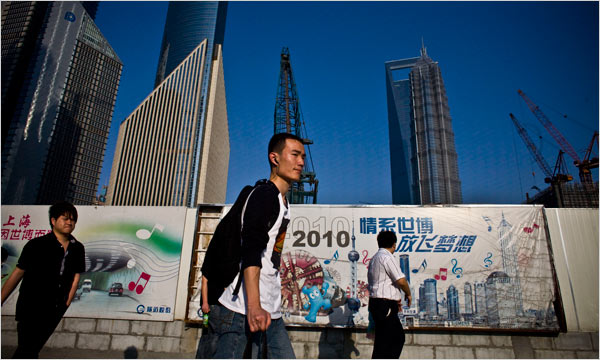|
|


ADVERTISEMENT
Buy Your own advertising
spaces!
.
Download Adobe Acrobat Reader to open [PDF] files.
Recent Visitors
Shanghai Buys Itself a Makeover Before a Fair
2009. 30 May
Although the World Expo may have lost much of the luster it had when it was better known as the World’s Fair, and though the global financial crisis drags on, apparently no one has told Shanghai: the city is planning to spend $45 billion, more than was spent on the Beijing Olympics, by DAVID BARBOZA
by DAVID BARBOZA
(nytimes.com)
Less than a year after Beijing hosted the Summer Olympics, Shanghai is gearing up for its own mega-event: the 2010 World Expo.
Architects and city planners say Shanghai is using the Expo as an excuse to go on a huge spending spree that will help stimulate a weakening local economy but also push forward an already breathtaking transformation in this city of 18 million.
“Every city has its own historical moment to transform and develop itself, and now it is Shanghai’s moment,” said Tu Qiyu, a professor of urban studies at the Shanghai Academy of Social Sciences.
The Expo is also advancing a larger government goal of bolstering the economy and turning Shanghai into a global financial center and a world-class city.
The makeover’s scope is spectacular. By the time the six-month-long exposition opens next May, Shanghai will have two new airport terminals, a subway system that is nearly as large as New York’s and a $700 million promenade in its historic riverfront district. New parks, roads and bridges are already opening.
Among the biggest worries for city officials is the possibility that the United States may not be able to take part in the exposition, which is held every five years.
Because of a federal law that restricts the use of government funds, American participation in an exposition depends on donations and corporate sponsors. Washington is supporting a nonprofit group trying to raise $61 million to build and operate an American pavilion.
With the economic downturn hampering fund-raising, the group has managed to raise only about $6 million. But Franklin L. Lavin, the chairman of the committee charged with financing the pavilion, remains optimistic. “We have about $36 million under negotiation and we are on schedule to reach our target,” he wrote in a recent e-mail message.
Participation in the Expo is no small matter to the Chinese government, which views the event as another opportunity for China to celebrate its re-emergence as a global power. So the government has declared the fair a national priority and even pressed Secretary of State Hillary Rodham Clinton during her visit in February to commit to an American presence here.
Expo organizers realize that a vast majority of the 70 million people expected to visit next year will come from neighboring Chinese provinces. But the city is still eager to impress the world.
Following Beijing’s example, Shanghai is asking residents to study English and vowing to teach etiquette to one million local families. The city also plans to ban smoking in public places and curtail pollution during the event.
The Expo site itself is a bold statement about the Chinese government’s resolve. The city says that to clear a huge site along the Huangpu River, which snakes through the heart of Shanghai, it relocated 18,000 families and about 270 factories, including the colossal Jiang Nan Shipyard, which employs 10,000 workers.
The city then handed about 1,300 acres of riverfront land over to the Expo.
“They can mandate these things,” said Koon Wee, an architect based in Hong Kong who is working on an Expo project. “Remember the Three Gorges Dam? They knew they had to drown villages. But they did it.”
Today, the Expo area is a vast construction zone. Rising on the south bank of the Huangpu River is the Chinese pavilion, a giant structure that looks like an upside down pyramid.
Nearby, construction is under way on a $270 million sports arena and performing arts center. The building, which is shaped like a flying saucer, will be partly operated by a venture created with the National Basketball Association, which is eager to expand its image in China.
The Expo has, however, had its problems. A corruption scandal in 2005 toppled Shanghai’s powerful party boss, Chen Liangyu, a prime driver of the Expo. He was sentenced to 15 years in prison last year for corruption and ties to big spending projects.
City officials also say that some Expo participants are scaling back their plans. And they admit that the largely government-financed Expo could lose $120 million. The budget for the Expo alone is about $4.2 billion — more than the cost of the Beijing Olympics. And some analysts say it could be multiples of that because the Expo budget does not include some costs, like relocating families and factories.
And despite a multiyear marketing blitz, the Expo has failed to inspire many residents here.
“I’m not excited about it; it creates lots of problems and inconveniences,” said Shi Yuan, a 24-year-old postgraduate student in Shanghai. “Everywhere is under construction, every road. It’s hard to get anywhere.”
Wang Yi, an accountant, said the Expo was seen as a kind of cure-all for the economy. “The government needs something to boost the economy, and let people feel confident,” she said.
The city’s riverfront is getting the biggest makeover, with parks, promenades and entertainment areas.
Officials have also approved a plan to go ahead with the Shanghai Tower, a 2,073-foot-tall building that, when completed in 2014, will stand about 70 percent taller than the Empire State Building.
Here in Shanghai, the potentially monstrous building is already being called the Dragon.


